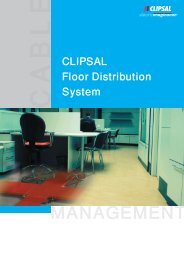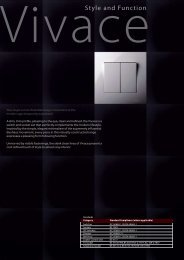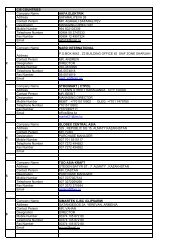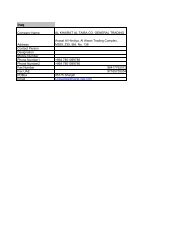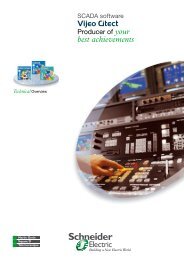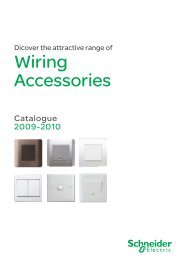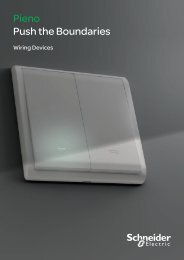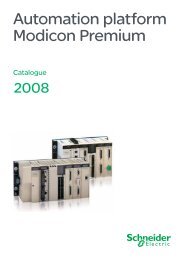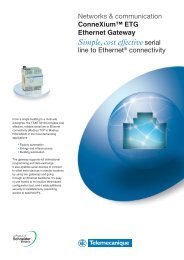Automation platform Modicon Premium - Schneider Electric
Automation platform Modicon Premium - Schneider Electric
Automation platform Modicon Premium - Schneider Electric
Create successful ePaper yourself
Turn your PDF publications into a flip-book with our unique Google optimized e-Paper software.
1<br />
2<br />
3<br />
4<br />
5<br />
6<br />
7<br />
8<br />
9<br />
10<br />
Memory structure<br />
Processor without PCMCIA memory card<br />
Internal RAM<br />
1<br />
1<br />
Presentation:<br />
page 1/4<br />
2<br />
1/8<br />
96 to 2048 Kb<br />
Located data<br />
Global and DFB<br />
unlocated data<br />
Program, symbols and<br />
area for online program<br />
modification<br />
Constants<br />
Processor with PCMCIA memory card in slot no . 0<br />
Internal RAM<br />
PCMCIA card<br />
(slot no. 0)<br />
96 to 2048 Ko<br />
128 to 7168 Ko<br />
Located data<br />
Global unlocated data<br />
DFB unlocated data<br />
DFB unlocated data<br />
Program and symbols<br />
Constants<br />
Additional data storage<br />
Processor with data storage type memory card in slot no . 0<br />
Internal RAM<br />
PCMCIA data<br />
storage card<br />
(slot no. 0)<br />
96 to 2048 Kb<br />
4096 or 8192 Ko<br />
Located data<br />
Unlocated data<br />
Program, symbols and<br />
area for online program<br />
modification<br />
Constants<br />
Additional data storage<br />
Description:<br />
pages 1/5 …<br />
1<br />
1<br />
2<br />
3<br />
1<br />
1<br />
1<br />
2<br />
3<br />
4<br />
1<br />
1<br />
2<br />
3<br />
4<br />
<strong>Modicon</strong> <strong>Premium</strong><br />
automation <strong>platform</strong><br />
Unity processors<br />
Memory structure<br />
The application memory is divided into memory areas, which are physically<br />
distributed across the internal RAM and 0, 1 or 2 PCMCIA memory extension cards:<br />
1 The application data, which is always found in the internal RAM, is divided into<br />
two possible types:<br />
v Located data, corresponding to data defined by an address (e.g. %MW237),<br />
which can have a symbol linked to it (e.g. Counter_rejects).<br />
v Unlocated data, corresponding to data defined only by a symbol. This type of<br />
addressing eliminates the problems of memory mapping management, because<br />
addresses are assigned automatically. It also facilitates data structuring.<br />
v DFB unlocated data, corresponding to DFB user function block data. The size of<br />
this area (which is determined by the physical size of the available internal RAM)<br />
depends on the processor model, see pages 1/12 and 1/13.<br />
2 Area in internal RAM or PCMCIA memory card for the program and symbols. If<br />
this area happens to be inside the internal RAM, it also contains the area for<br />
modifying the program in online mode (1).<br />
This area contains the program's executable binary code and IEC source code.<br />
The user selects the type of information to be stored in the PLC memory.<br />
3 Constants area in the internal RAM or the PCMCIA memory card (slot no. 0)<br />
4 Area for storing additional data (slot no. 0 or no. 1), e.g. for production data and<br />
manufacturing recipes<br />
Memory organization<br />
The memory will be organized in one of two ways, depending on whether the<br />
<strong>Premium</strong> processor is fitted with 0, 1 or 2 memory extension cards:<br />
b Application in internal RAM: In this case, the application is completely loaded into<br />
the processor's internal battery-backed RAM (2), the capacity of which depends on<br />
the processor model (96 Kb to 2 Mb).<br />
b Application in PCMCIA card: In this case, the internal RAM is reserved for the<br />
application data. The PCMCIA memory card (slot no. 1) contains the program space<br />
(program, symbols and constants areas) (128 Kb to 2 Mb). Certain types of PCMCIA<br />
memory card also host the data storage area (max. 6976 Kb).<br />
Symbols areas<br />
Having the symbols area in the same place as the program area is optional.<br />
However, if the application symbols database is available on the PLC, it means that,<br />
when an empty programming terminal is connected to the PLC, all the elements<br />
needed to debug or upgrade this PLC can be transferred to the terminal.<br />
__________________________________________________________________<br />
(1) If a PCMCIA card has been inserted, it is the memory on this memory card that will be used<br />
for the purpose of modifying the program in online mode (outside areas 2, 3 and 4 opposite).<br />
(2) The internal RAM is backed up by an optional battery (with a service life of 3 years), which is<br />
located in the power supply module (see page 2/4) .<br />
Characteristics:<br />
pages 1/10 …<br />
References:<br />
pages 1/12 …<br />
PCMCIA references:<br />
pages 1/22 …


